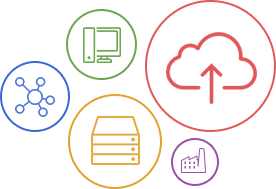When technology comes to a halt, so does your business. IT issues can spring up without any warning, turning an ordinary day into a wave of productivity loss and heightened stress levels.
Every minute lost to IT hiccups isn't just a minor inconvenience; it's a direct hit to your business’s bottom line and ability to serve customers effectively.
According to a new survey, employees waste 22 minutes each day, on average, dealing with IT-related issues. For someone who works five eight-hour days for 50 weeks of the year, that translates into a loss of more than 91 hours per year.
Such interruptions can stall your operations, strain relationships with clients, and lead to significant financial losses.
As Emil Isanov, CEO and Founder of ETech 7 says, "Transformative IT management begins with pinpointing and rectifying the root cause of the problem."
This guide aims to empower businesses with the knowledge and tools to confront and conquer IT challenges head-on. We'll equip you with strategies to not only resolve immediate issues but also to build a robust IT framework that supports long-term business growth and stability.
Solving Common IT Problems in Business
1. Data Loss: Prevention and Recovery Tactics
Accidentally deleting important files or experiencing a system crash without a recent backup can be disastrous. Research shows that only 54% of businesses have a properly documented disaster plan, highlighting the need for a systematic approach to data backup and recovery.
Utilize cloud storage solutions for redundancy, and establish regular backup schedules to ensure data integrity. In case of data loss, having a predefined recovery process can significantly reduce downtime and stress.
You Don’t Need to be Drowning in IT Problems
2. Cybersecurity Challenges: Building a Fortified Defense
A robust cybersecurity strategy is non-negotiable in an age of increasingly common cyber-attacks and data breaches. Start with comprehensive risk assessments to identify vulnerabilities.
Implement layered security measures including firewalls, anti-malware software, and intrusion detection systems. Regularly update your security protocols and educate your team about best practices in digital hygiene to fortify your defenses against cyber threats.
3. Slow Internet Connectivity: Enhancing Your Network's Speed
A sluggish internet connection can hamper your team's productivity and frustrate your clients. To address this, assess your current network setup and bandwidth requirements.
Consider upgrading to higher-speed services or optimizing your network infrastructure. Monitor your network performance regularly to identify and rectify bottlenecks promptly.
4. Software and Hardware Issues: Ensuring Reliability and Performance
Regular maintenance is key to preventing unexpected software and hardware failures. Keep your systems updated with the latest patches and upgrades.
Conduct periodic audits to check the health of your hardware, and replace components that are at risk of failure. Establishing a proactive maintenance routine can minimize disruptions and extend the lifespan of your IT assets.
5. Access and Data Security: Safeguarding Your Information
Controlled access to data is vital for maintaining its security.
Implement strict access controls and authentication protocols to ensure only authorized personnel can access sensitive information. Regularly review access logs and adjust permissions as necessary to maintain a secure and efficient data access framework.
6. Email Issues: Ensuring Smooth Communication
Email is a vital communication tool for businesses, and disruptions can lead to missed opportunities and communication breakdowns. Common issues include spam, phishing attempts, and email system outages.
To combat these, implement advanced email filtering, educate employees on recognizing phishing attempts, and ensure your email system is hosted on a reliable platform with redundancy in place.
7. Network Downtime: Maintaining Connectivity
Network downtime can isolate your business, halting operations and damaging client relations.
Proactive monitoring of your network can alert you to potential issues before they cause downtime. Implementing redundant network paths and having a contingency plan can ensure connectivity remains consistent, even during unforeseen events.
8. Inadequate IT Support: Enhancing Response Times
When IT issues arise, swift resolution is key. However, businesses often struggle with inadequate IT support that cannot keep up with demand.
This can be mitigated by scaling your IT support to match your business needs by expanding your in-house team or getting remote IT support that can provide rapid, expert assistance.
9. Compliance and Regulatory Challenges: Navigating Legal Requirements
Businesses must navigate a complex landscape of regulatory requirements, particularly concerning data protection and privacy. Non-compliance can result in hefty fines and reputational damage.
To avoid this, stay informed about relevant regulations, conduct regular compliance audits, and implement policies and technologies that ensure data is handled promptly.
10. Disaster Recovery Planning: Preparing for the Worst
Many businesses are unprepared for disasters, be they natural, technical, or human-induced.
Without a disaster recovery plan, a business can struggle to resume operations after an incident. Develop a comprehensive disaster recovery strategy that includes data backups, resource allocation, and detailed procedures for restoring IT operations after a disruption.
|
More resources you might like: |
11. Mobile Device Management: Securing a Mobile Workforce
With the rise of remote work and BYOD (Bring Your Own Device) policies, managing many mobile devices can become a significant IT challenge.
Implementing mobile device management (MDM) solutions can help control and secure these devices, ensuring they comply with company policies and do not pose a security risk.
12. Scalability of IT Systems: Keeping Up with Growth
As businesses grow, their IT infrastructure needs to scale accordingly. Systems that work for a small team may not suffice for a larger organization.
Regularly assess your IT infrastructure's scalability and invest in solutions that can grow with your business, preventing bottlenecks and performance issues as your company expands.
Best Practices for IT Problem Management
|
Best Practice |
Description |
Impact on IT Problem Management |
|
Proactive Monitoring |
Continuously monitor IT systems to detect issues early. |
Reduces downtime by identifying problems before they escalate. |
|
Comprehensive Documentation |
Maintain detailed documentation of IT systems and procedures. |
Enhances understanding and speeds up issue resolution. |
|
Regular Training for IT Staff |
Provide ongoing training for IT personnel on latest technologies and problem-solving techniques. |
Improves team's ability to resolve issues efficiently and effectively. |
|
User Education and Communication |
Educate non-IT staff about basic IT troubleshooting and security awareness. |
Empowers users to avoid common issues and identify potential problems early. |
|
Incident Management Process |
Establish a clear process for logging, tracking, and resolving IT incidents. |
Ensures consistent and systematic resolution of IT problems. |
|
Periodic System Updates and Maintenance |
Regularly update and maintain IT systems to prevent vulnerabilities. |
Reduces the incidence of problems caused by outdated software or hardware. |
|
Disaster Recovery and Business Continuity Planning |
Develop and regularly update disaster recovery and business continuity plans. |
Minimizes the impact of major incidents on business operations. |
|
Vendor Management and Collaboration |
Maintain strong relationships with IT vendors and service providers. |
Ensures timely support and access to expertise when dealing with specialized systems or software. |
|
Feedback Loop |
Implement a system for collecting and analyzing feedback post-resolution. |
Helps in continuously improving the IT problem management process. |
|
Investment in IT Infrastructure |
Regularly assess and invest in IT infrastructure to meet current and future needs. |
Prevents issues related to inadequate or obsolete technology resources. |

Say Goodbye to IT Problems with Etech7
Navigating IT problems is pivotal for maintaining your business's momentum and integrity. Adopting a strategic approach to IT management can transform these challenges into opportunities to enhance operational efficiency and secure your business's digital future.
|
Discover Trusted IT Support Services Near You: |
Looking for expert guidance? Etech7 is your ally in this journey, offering expert-managed IT services to fortify your technological backbone.
Contact us for a free consultation and take the first step towards a resilient, efficient IT infrastructure that propels your business forward.














